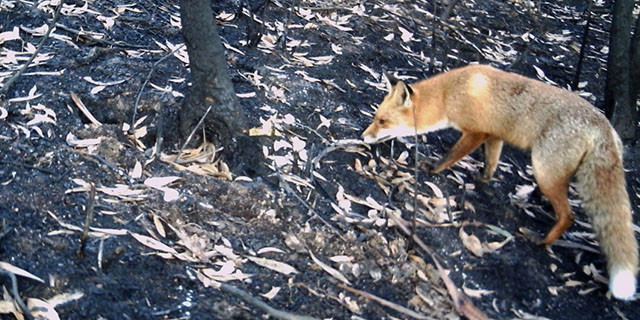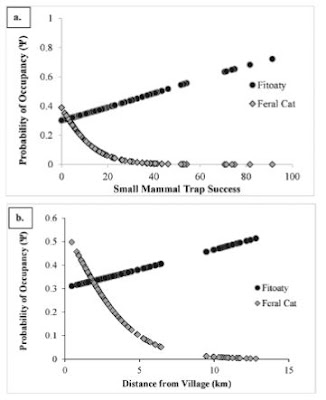Hradsky, B. A. K. (2016). Interactions between invasive predators, native mammals and fire in a forest ecosystem (Doctoral dissertation, University of Melbourne).
A predator’s impact upon its prey depends not only on the evolutionary history and intrinsic characteristics of the two species, but also on the structure of the environment in which they interact. Fire is a major driver of vegetation structure, and there is growing concern that fire could increase the threat that invasive predators pose to native fauna. In this thesis, I investigated the interactions between fire, two invasive predators (red foxes
Vulpes vulpes and feral cats
Felis catus), and a suite of native mammal species. I used four different approaches to examine this problem within a fire-prone forest ecosystem of south-eastern Australia.

At a landscape-scale, species distributions are often poorly predicted by time-since-fire. I developed a conceptual model of the potential interactions between fire and other drivers of faunal occurrence (including predation), and then used non-parametric Bayesian networks to quantify these relationships for terrestrial native mammals. I found that critical-weight-range mammals were more likely to occur at long unburnt sites with high habitat complexity, and in wetter forest types. In contrast, large macropods preferred less complex habitats and younger or drier forest. Species distributions were generally more strongly associated with habitat complexity than time-since-fire or invasive predator occurrence. Yet, because Bayesian networks captured the relationships between proximal and distal drivers, models could effectively predict the distributions of most species using only mapped and remote-sensed data.
At a finer-scale, I used a before-after control-impact experiment to investigate the short-term effects of a prescribed fire on understorey vegetation cover, native mammal occurrence, and invasive predator occurrence and diet. Associations between species occurrences and vegetation cover in unburnt forest indicated that fire was likely to promote invasive predators but disadvantage small- and medium-sized native mammals. After the fire, there was a five-fold increase in invasive predator occurrence at burnt sites, relative to the control. Concurrently, red foxes increased their consumption of medium-sized native mammals, and selected more strongly for long-nosed bandicoots Perameles nasuta and short-beaked echidnas Tachyglossus aculeatus. The occurrence of several native mammals declined after the fire, but it was difficult to distinguish the effects of the fire from seasonal variation.
I used GPS-tracking collars to investigate whether forest-dwelling red foxes selected for human-modified habitats (including recently-burnt forest). There was substantial variation in fox behaviour, highlighting the importance of considering individual variation in habitat selection studies. At a broad-scale, however, red fox habitat selection tended to vary with proximity to the forest edge. Most foxes selected for human-modified habitats such as reservoirs, roads and forest-farmland edges in their fine-scale movements, particularly at night. Two foxes whose home-ranges overlapped a burn-block intensified their use of the block immediately after fire. Yet other nearby foxes showed little response, suggesting that fire responses are highly localised.
Finally, I used an agent-based simulation model to explore how changes in vegetation cover and predator abundance after fire could affect a critical-weight-range mammal. The model confirmed that fire and predation can have synergistically negative impacts on native mammal populations in burnt forest, and that local access to unburnt refuges substantially reduces these effects.
Invasive predators are highly opportunistic, wide-ranging and thoroughly integrated into this flammable forest ecosystem. Lethal control programs for foxes need to consider fox movement across land-tenures, and could selectively target habitat features such as roadsides, forest-farmland edges and recently-burnt forest. Habitat-based management approaches might also reduce invasive predator impacts on native mammals, for example by preserving dense vegetation in unburnt refuges, or removing anthropogenic resources that subsidise predator populations within forests. Evidence-based, integrated management of threatening processes is vital to conserving native biodiversity.









